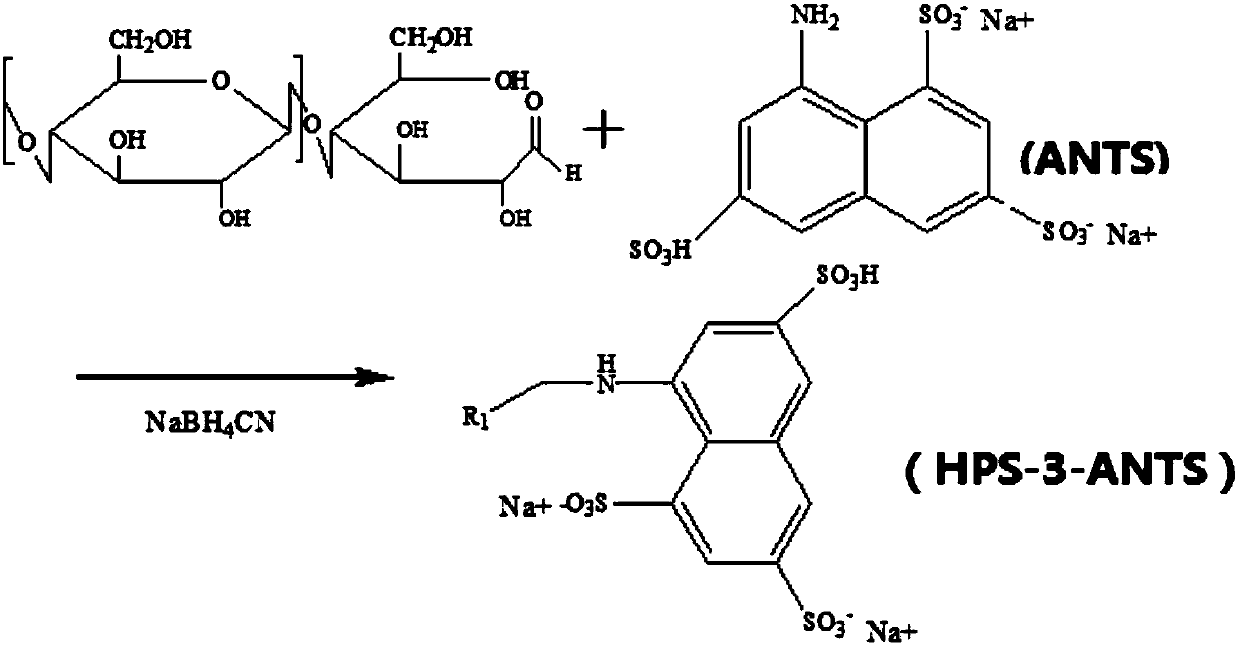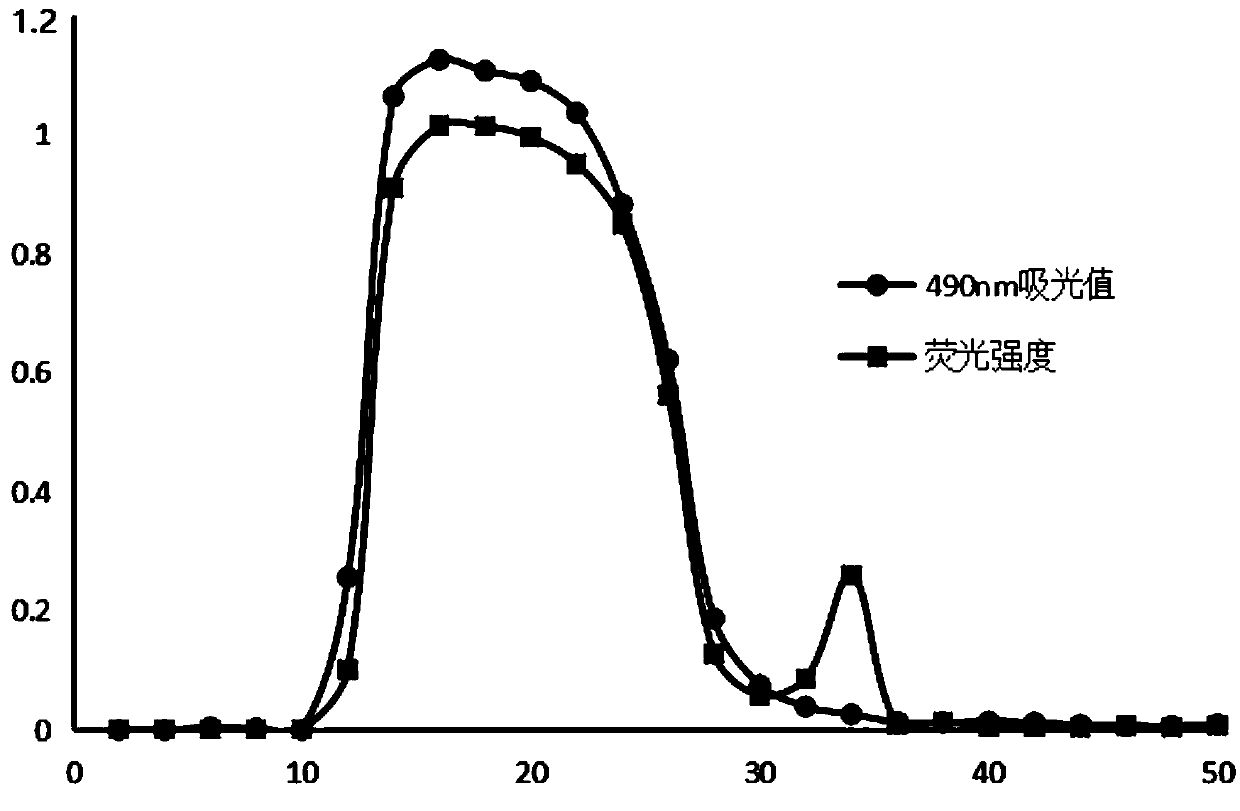Method for using fluorescence to label hedysarum polybotrys saccharide and hedysarum polybotrys saccharide labeled through method and application of hedysarum polybotrys saccharide
A technology of fluorescent labeling and Radix Astragalus polysaccharides, which is applied in chemical instruments and methods, luminescent materials, pharmaceutical formulations, etc., can solve problems such as difficult direct detection, slow progress in research on molecular mechanism of action and metabolic kinetics, and lack of luminescent groups
- Summary
- Abstract
- Description
- Claims
- Application Information
AI Technical Summary
Problems solved by technology
Method used
Image
Examples
Embodiment 1
[0037] Example 1 Preparation of ANTS-labeled Astragalus polysaccharide HPS-3
[0038]Pulverize the Radix Radix Radix Radix Radix, add 6 times the amount of ethyl acetate at 80°C for reflux extraction 3 times, each time for 1.5h, evaporate the solvent; then add 6 times amount of ethanol for 80°C reflux extraction for 3 times, each time for 1.5h, evaporate Dry the solvent; finally add 10 times the amount of water and soak at 60°C for 3 times, each time for 1h, filter, and combine the filtrates. Add ethanol to the filtrate to make the final concentration of ethanol 50%, let it stand for centrifugation, add ethanol to the supernatant to make the final concentration of ethanol 70%, let it stand and centrifuge to get the precipitate as crude HPS-3, and use the Sevage method to prepare the crude HPS-3 Deproteinization, H 2 o 2 The pigment was removed by method, dialyzed, and freeze-dried to obtain purified HPS-3.
[0039] Dissolve 500mg of HPS-3 in water, add 58.5ml of 0.02mol / l A...
Embodiment 3
[0049] Example 3 Preparation of FITC-labeled Astragalus polysaccharide HPS-3
[0050] Take 400mg HPS-3 and dissolve in 100ml 0.2mol L -1 Phosphate buffer (pH8.0), add 400mg tyramide (Tyr) to react at room temperature for 24h. After the reaction, add 150 mg of sodium cyanoborohydride (solid), and react in a water bath at 30° C. for 60 h, shaking occasionally. After the reaction is completed, centrifuge, take the supernatant, pass through the Sephadex G-25 column, elute with distilled water, collect 10ml of the eluate in each tube, measure the sugar content in each tube by the phenol-sulfuric acid method, and measure the 280nm ultraviolet absorption value with a UV-visible spectrophotometer. The elution curve of HPS-3-Tyr was drawn, and the eluents were combined according to the elution curve, and freeze-dried to obtain HPS-3-Tyr.
[0051] The experiment finds that adding solid sodium cyanoborohydride and adding sodium cyanoborohydride dissolved in dimethyl sulfoxide has littl...
Embodiment 5
[0062] Example 5 Study on tissue distribution of ANTS-labeled Astragalus polysaccharide HPS-3
[0063] 48 Kunming mice were randomly divided into 8 groups, with 160mg·kg -1 The dose of HPS-3-ANTS was administered through the tail vein, and the cervical vertebrae were sacrificed at 0, 0.25, 0.5, 1, 1.5, 2, 3, and 4 hours after administration, and the heart, liver, spleen, lung, kidney, and stomach were quickly removed. , intestine, brain and other tissues, rinse the surface blood and contents with normal saline, weigh the wet weight of each organ respectively, put them into a centrifuge tube, add 9 times the volume of normal saline, prepare a homogenate, centrifuge, and take the supernatant Freeze at -80°C. Thaw at room temperature immediately before use, and use a fluorescence photometer (λ ex =366nm,λ em = 500nm) to measure the fluorescence intensity, put the fluorescence intensity into the corresponding standard equation to obtain the drug concentration, draw the tissue c...
PUM
 Login to View More
Login to View More Abstract
Description
Claims
Application Information
 Login to View More
Login to View More - R&D
- Intellectual Property
- Life Sciences
- Materials
- Tech Scout
- Unparalleled Data Quality
- Higher Quality Content
- 60% Fewer Hallucinations
Browse by: Latest US Patents, China's latest patents, Technical Efficacy Thesaurus, Application Domain, Technology Topic, Popular Technical Reports.
© 2025 PatSnap. All rights reserved.Legal|Privacy policy|Modern Slavery Act Transparency Statement|Sitemap|About US| Contact US: help@patsnap.com



